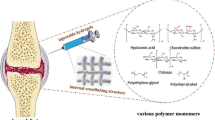Abstract
Hydrogels are widely used in medicine and offer advantages in many implant situations. However, the body responds to them as with any other material — by walling them off in a foreign body capsule. We show here that by making hydrogels with uniform, interconnected spherical pores of about 35 microns, the healing reaction can be shifted to one of vascularization and little fibrosis. We have also developed a biodegradable form of poly(2-hydroxyethyl methacrylate) that can be used to fabricate these pro-healing, spherically pored materials.
Access this chapter
Tax calculation will be finalised at checkout
Purchases are for personal use only
Preview
Unable to display preview. Download preview PDF.
Similar content being viewed by others
References
Wichterle O, Lim D (1960) Hydrophilic gels for biological use. Nature 185:117–118
Anderson JM, Rodriguez A, Chang DT (2008) Foreign body reaction to biomaterials. Seminars in Immunology 20:86–100
Atzet S, Curtin S, Trinh P, Bryant S, Ratner B (2008) Degradable poly(2-hydroxyethyl methacrylate)-co-polycaprolactone hydrogels for tissue engineering scaffolds. Biomacromolecules, doi: 10.1021/bm800686h
Brand KG, Buoen LC, Johnson KH, Brand I (1975) Etiological factors, stages and the role of the foreign body in foreign body tumorigenesis: a review. Cancer Res 35:279–286
Picha GJ, Siedlak DJ (1984) Ion-beam microtexturing of biomaterials. MD & DI 6(4): 39–42
Clowes AW, Kirkman TR, Reidy MA (1986) Mechanisms of arterial graft healing-rapid transmural capillary ingrowth provides a source of intimal endothelium and smooth muscle in porous PTFE prostheses. Am J Path 123(2):220–230
Brauker JH, Carr-Brendel VE, Martinson LA, Crudele J, Johnston WD, Johnson RC (1995) Neovascularization of synthetic membranes directed by membrane microarchitecture. J Biomed Mater Res 29:1517–1524
Sharkawy AA, Klitzman B, Truskey GA, Reichert WM (1997) Engineering the tissue which encapsulates subcutaneous implants. I. diffusion properties. J Biomed Mater Res 37:401–412
Marshall AJ, Irvin CA, Barker T, Sage EH, Hauch KD, Ratner BD (2004) Biomaterials with tightly controlled pore size that promote vascular in-growth. ACS Polymer Preprints 45(2): 100–101
Isenhath SN, Fukano Y, Usui ML, Underwood RA, Irvin CA, Marshall AJ, Hauch KD, Ratner BD, Fleckman P, Olerud JE (2007) A mouse model to evaluate the interface between skin and a percutaneous device. J Biomed Mater Research A 83:915–922
Khelfallah NS, Decher G, Mesini PJ (2007) Design, synthesis, and degradation studies of new enzymatically erodible poly(hydroxyethyl methacrylate)/poly(ethylene oxide) hydrogels. Biointerphases 2(4): 131–135
Bolgen N, Yang Y, Korkusuz P, Guzel E, El Haj AJ, Piskin E (2008) Three-dimensional ingrowth of bone cells within biodegradable cryogel scaffolds in bioreactors at different regimes. Tissue Engineering A 14:1743–1750
Van Thienen TG, Lucas B, Flesch FM, van Nostrum CF, Demeester J, De Smedt SC (2005) On the synthesis and characterization of biodegradable dextran nanogels with tunable degradation properties. Macromolecules 38(20):8503–8511
Lim DW, Choi SH, Park TG (2000) A new class of biodegradable hydrogels stereocomplexed by enantiomeric oligo (lactide) side chains of poly(HEMA-g-OLA)s. Macromol Rapid Commun 21:464–471
He B, Wan E, Chan-Park MB (2006) Synthesis and Degradation of Biodegradable Photo-Cross-Linked Poly (a,β-malic acid)-Based Hydrogel. Chem. Mater 18:3946–3955
Matyjaszewski K, Xia J (2001) Atom transfer radical polymerization. Chem Rev 101(9):2921–2990
Author information
Authors and Affiliations
Rights and permissions
Copyright information
© 2009 Springer-Verlag Italia, Milan
About this chapter
Cite this chapter
Ratner, B.D., Atzet, S. (2009). Hydrogels for Healing. In: Hydrogels. Springer, Milano. https://doi.org/10.1007/978-88-470-1104-5_5
Download citation
DOI: https://doi.org/10.1007/978-88-470-1104-5_5
Publisher Name: Springer, Milano
Print ISBN: 978-88-470-1103-8
Online ISBN: 978-88-470-1104-5
eBook Packages: Chemistry and Materials ScienceChemistry and Material Science (R0)




